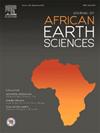Hydrogeochemical and isotopic characterization of the El-Tarf geothermal aquifer (Algerian−Tunisian border): Implications of the regional geodynamic structure and the water−rock interactions
IF 2.2
4区 地球科学
Q2 GEOSCIENCES, MULTIDISCIPLINARY
引用次数: 0
Abstract
The geothermal aquifer complex investigated in this study comprises a component of the eastern geothermal reservoir of Northern Algeria that is located close to the Algerian−Tunisian border. Seven thermal and two cold water springs were sampled in the framework of this study. The area hosts the region's second hottest spring discharging at a temperature of 67 °C. The thermal waters are carbogaseous type and are dominated by a Na−HCO3 composition. Isotopic analyses of deuterium and oxygen-18 confirm their meteoric origin. Radiogenic strontium isotopes (87Sr/86Sr up to 0.710841) suggest interactions with a silicate basement, probably composed of granodiorites and micaschists. Interaction with the Triassic evaporites results in a total dissolved solids (TDS) concentration of up to 1773 mg L−1. The thermal waters emerging through the faults have a temperature ranging between 36 and 67 °C. These waters mix with cooler waters during their ascent. The use of various chemical geothermometers yielded a maximum reservoir temperature of 78–162 °C for the Bouhadjar region. Using the average regional geothermal gradient (43.5 °C·km−1) and the aforementioned temperature interval, an estimated depth range of 1793–3731 m was computed for the geothermal water reservoir. All the thermal waters are found oversaturated with respect to kaolinite and K−mica reflecting the dissolution of granodiorites and muscovite-rich micaschists. High PCO2 levels (0.07–1.07 atm) suggest the existence of a thermo-decarbonation reaction taking place in the tectonic collision zone. This highlights the important role played by major geological structures occurring in such a geothermal system.

求助全文
约1分钟内获得全文
求助全文
来源期刊

Journal of African Earth Sciences
地学-地球科学综合
CiteScore
4.70
自引率
4.30%
发文量
240
审稿时长
12 months
期刊介绍:
The Journal of African Earth Sciences sees itself as the prime geological journal for all aspects of the Earth Sciences about the African plate. Papers dealing with peripheral areas are welcome if they demonstrate a tight link with Africa.
The Journal publishes high quality, peer-reviewed scientific papers. It is devoted primarily to research papers but short communications relating to new developments of broad interest, reviews and book reviews will also be considered. Papers must have international appeal and should present work of more regional than local significance and dealing with well identified and justified scientific questions. Specialised technical papers, analytical or exploration reports must be avoided. Papers on applied geology should preferably be linked to such core disciplines and must be addressed to a more general geoscientific audience.
 求助内容:
求助内容: 应助结果提醒方式:
应助结果提醒方式:


